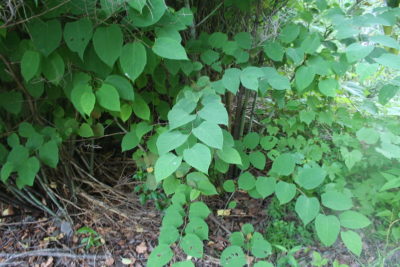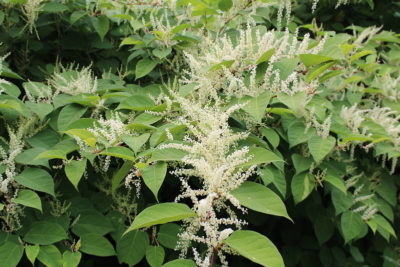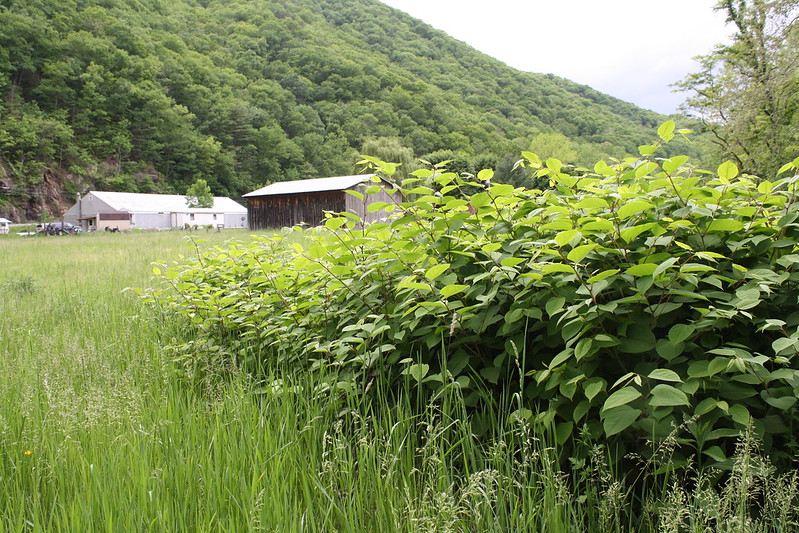Japanese knotweed (Fallopia japonica) is a non-native, invasive plant species initially introduced as an ornamental plant from Asia. Knotweed forms dense thickets 3–10 feet in height, outcompeting native plants in the process through limiting light to other species, allelopathy (releasing chemicals that suppress other plants from growing in the same location), and altering nutrient cycling. Knotweed’s aggressive growth can penetrate asphalt and concrete, and can even damage foundations to buildings. Note that Japanese knotweed is legally prohibited in Michigan. It is illegal to possess or introduce (plant) this species without a permit from the Michigan Department of Agriculture and Rural Development.

Japanese knotweed. Photo: NYS IPM Program of Cornell University
Knotweed spreads vigorously through rhizomes, which means it spreads by its roots sending up new shoots. Unfortunately, this method of spread means the plant is very difficult to eradicate, either through manual methods such as digging or mowing, or through the use of chemical herbicides. Even a small fragment of root left in the ground is enough for Japanese knotweed to continue to grow and spread, and a knotweed plant that has been treated may send up new shoots up to three years after treatment if there are any surviving rhizomes. Roots may extend horizontally underground from the plant for up to 65 feet. In the winter, its hollow stems stay standing and look like bamboo stalks. Additionally, fragments of knotweed stems can also sprout. This poses a great threat, especially along rivers and streams, where plant pieces may wash downstream and establish new colonies. Japanese knotweed can also be unintentionally spread during construction and road maintenance by mowing or in fill dirt.

Japanese knotweed in flower. Photo: Zachary Simek
How To Identify
Japanese knotweed is a tall shrub with arching stems, large ovate leaves (oval-shaped with a narrow point at one end); the leaves are alternately arranged on the stem and have smooth edges (not toothed). The leaves are relatively large and broad, up to 6 inches in length and 4 to 5 inches wide. Japanese knotweed flowers in August and September, and flowers are tiny and white or pale green, forming a white haze over the entire bush. The flowers are arranged in spikes that grow out from the leaf bases.
Japanese knotweed hybridizes with giant knotweed and forms a fertile hybrid plant, called bohemian knotweed. Identification characteristics are very similar, but there are some differences. Read more about identification of knotweeds here: Midwest Invasive Species Information Network: Japanese knotweed.
What To Do
Luckily we have not yet found Japanese knotweed at Michigan Audubon sanctuaries. Still, it is present throughout Michigan, and we ask your help in being watchful for it when you’re visiting our sanctuaries or any park or preserve. You can help by reporting this highly invasive species to MISIN, the Midwest Invasive Species Information Network, through their website or mobile app. If you visit one of our six sanctuaries with a boot brush station at it, please brush mud and debris off your footwear both before and after walking the trails. This will help prevent the movement of “hitchhiker” seeds on your shoes into or out of the sanctuary!
If you find an infestation of Japanese knotweed on your property, your local county Conservation District is an excellent contact to reach out to. They can help you learn how to eradicate the plant, and some county area CISMA (Cooperative Invasive Species Management Area) groups may help with treatments.
Learn more about Japanese knotweed and how to reduce its spread in Michigan:
To learn more about best control practices for Japanese knotweed, check out the Michigan DNR factsheet here: https://mnfi.anr.msu.edu/invasive-species/JapaneseKnotweedBCP.pdf

